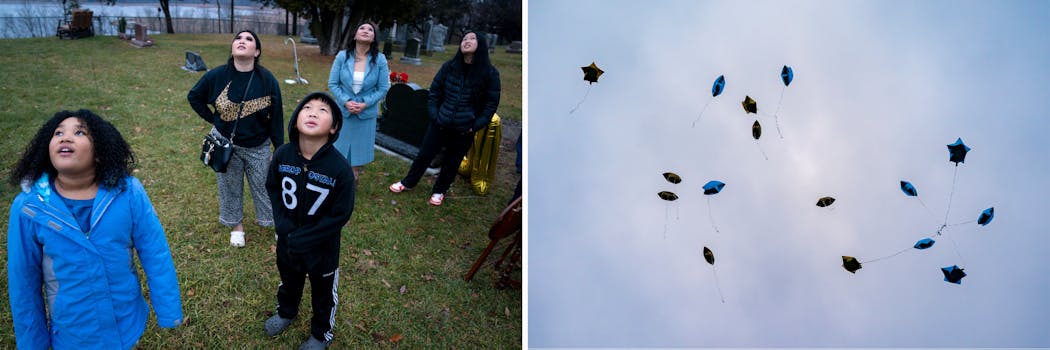Baky Mikaele kept one eye on the road as she strained to understand the call saying her 14-year-old son had been in an accident. For some reason, Mikaele pictured Jin thrashing in the lake where he'd been hanging out with his friends that summer. "Go help him!" she shouted into the receiver.
But Jin wasn't drowning.
Later, she sat next to him in North Memorial Hospital's pediatric trauma unit. She studied the dressed wounds above Jin's temple, where the bullet had entered his skull, and the second one on the other temple, where it had exited. Jin was alive, but with the help of machines. And not for long.
When Mikaele moved to Minnesota from Alaska a year earlier looking for a fresh start, she never imagined it would lead to her only son dying before he reached ninth grade. But it's happening more and more: As violent crime rose to near-record highs these past four years, as guns have become easier to find on the illegal market, young people are dying from firearm-related injuries in numbers not seen in at least three decades.
Fifty-nine people younger than 18 years old were killed in gun homicides statewide from 2020 to 2023 — more than the prior eight years combined, according to Minnesota Department of Health data. Another 38 kids were killed in gun-related suicides, accidents or in cases in which a medical examiner could not determine the manner of death. About 1/3 of gun-related juvenile deaths occurred in Minneapolis.
Some are caught in the crossfire of violent street feuds — bouncing on a trampoline or riding in their mom's car when the bullets fly. Others, police say, are soldiers in the street wars. Last fall, in Southern Minnesota, a 4-year-old climbed out of his car seat, found a gun in the glove box and shot his infant brother.
And then there is Jin's case. His manner of death is labeled "undetermined."
Police say Jin was with a group of friends in a house in north Minneapolis when it happened. One witness told investigators Jin shot himself. Others said they heard the gunfire and found Jin on the floor, but never saw who pulled the trigger. Jin didn't wake up to tell his side of the story.
"There's so many questions," his mother said, "but not many answers."
A life cut short
Jin Wongsid Lee Taylor was supposed to be a CEO.
As a kid in Anchorage, he helped his mom at the coffee shop she owned, and wanted to own a shop of his own one day.
He dreamt up all kinds of business schemes, like driving semi-trucks with his cousin Kefir on the West Coast. He was so eager to turn 16 and get his license, his mom started teaching him in the driveway. Before his death, he had been saving to buy a vending machine. He told his mom he'd use the money to help her buy a house.
Jin could be sweet like that. He hated getting his photo taken, but on school picture day he'd smile big so his mom could have at least one to display on the mantel.
It was Jin who'd wanted to move to Minnesota. His dad died when he was 2 years old. After a divorce with Jin's stepdad, when Mikaele decided to leave Alaska, she gave serious thought to California. But Jin wanted to be near his cousins.
In his first year in Minnesota, Jin spent his weekends going to the beach and riding roller coasters at Valley Fair.
One summer morning, Mikaele woke up early from a nightmare about Jin. He'd been staying at his cousin's the past few nights. "You have to come home today," she told him.
Jin said he'd catch a ride home with a family member. He called later to say he was going to the mall for a friend's birthday.
Mikaele was driving home that night from a family picnic when her sister called to say Jin had been in an accident.
"I just screamed so loud," Mikaele recalled. "Everything just stopped."
The investigation
Minneapolis police officers met Mikaele at the hospital that night.
She assumed their investigation would soon reveal the origin of the gun, who fired it and why. Over the next few days, as police interviewed the witnesses, these questions burned in her mind.
No adults had been home when it happened, so the case hinged on recollections of traumatized teens, most so young they needed their parents' permission to talk to police. They gave varying accounts of what they saw, according to the officers' reports and interview summaries.
One told investigators he and his girlfriend were in a bedroom when they heard a loud bang. He ran out into the living room and found Jin slouched over the couch's armrest, a gun in his hand.
Jin's cousin Kefir, then 15, told police he was in the basement when he heard people shouting that "Jin shot himself."
Another said he saw Jin with a gun. He "turned away, heard a gunshot, and then saw smoke," and another friend ran out of the room.
The one who ran texted a 13-year-old girl later to ask if she saw Jin shoot himself. The witness "encouraged [the girl] to tell the cops that [she] saw Jin shoot himself so he would not go to jail for manslaughter." He said his fingerprints were on the gun, according to the police report. His family's attorney, Earl Gray, declined to comment.
The 13-year-old girl was the only one listed in the 88-page police report who said she actually witnessed Jin shoot himself. She wasn't there, but she was talking to her boyfriend over Facetime. She described what she saw through her boyfriend's phone: "Jin was playing with a gun when it fired, and people began screaming. Then the camera turned off."
She was "pretty sure" it was an accident. Others also said Jin was happy and smiling. None believed Jin would hurt himself on purpose.
Pressure
At the hospital, Jin's condition was getting worse. If he did wake up, the doctors said he might not be the same Jin.
Mikaele said she didn't care. "It's my baby. I would take care of him for the rest of my life."
His mother watched the numbers spike on a monitor above Jin's bed. He was suffering — Mikaele could see it.
On the eighth day in the hospital, she dressed Jin in a suit, trimmed his hair and pedicured his fingernails. She stood over his bed. It took less than the five minutes the doctors predicted from when they turned off the machines to the moment Mikaele felt the last beat of her son's heart.
She never gave up on Jin, even when police labeled the death a self-inflicted accident and closed the investigation. Mikaele hired a private investigator and a lawyer.
She contacted Jin's friends who were at the house. One sent her a phone video recorded just before the shooting. It showed Jin wearing a boxing glove, throwing slow-motion punches with another boy, grinning his great big Jin grin. The other boy was smiling too. She watched the footage carefully. There was no gun in the frame.
"I know my baby did not do it to himself," said Mikaele, sitting in her living room on a recent evening. "Someone did. And they just all stick to one story."
Not knowing what happened, she said, has made it impossible to find closure.
She wants to know where the gun came from. It had no serial number — one of more than 1,100 illegal firearms confiscated by Minneapolis police in 2022 — making it difficult to trace.
When a Star Tribune reporter asked Jin's cousin Kefir about the gun, he gave an answer that surprised Mikaele.
"It was Jin's," he said. The gun was Jin's.
"How do you know it was his gun?" Mikaele asked skeptically.
"He showed me," replied Kefir.
"Who gave it to him?"
"I don't know."
Asked by a reporter if he thinks Jin shot himself, maybe by accident, Kefir shook his head.
"No."
Mikaele said later she doesn't believe it. Jin hardly knew anyone in Minnesota, let alone a black market gun dealer. And even if it did belong to Jin, that meant someone sold a gun to a 14-year-old kid. Wasn't that evidence of a crime worth investigating?
'Happy Sweet 16′
On a gray December afternoon in Chisago City, an icy wind blew off Green Lake and through a nearby cemetery where a young girl and her father were inflating golden Mylar balloons in the shapes of "1″ and "6."
"Mommy's here, baby," said Mikaele, caressing Jin's face, which was aglow in a picture-day smile and printed on his headstone. "We're here to celebrate your birthday, baby."
The black-stone grave read: "Jin Wongsid Lee Taylor. Dec 9, 2007-June 23, 2022."
Lately it seemed like tragedy was stalking Mikaele. Her sister had died a few days earlier from complications related to West Nile Virus. Her son's was one of two memorials that day.
Mikaele imagined how tall Jin would have been today. The rest of the family is short, but Jin was going to be the exception, already 5′ 9″. She thought aloud of the times when she was sick and he'd make her breakfast and arrange the bacon and rice in the shape of a heart.
"I feel like it was yesterday," she said. "I still feel like he's at his friend's house, or he's gone to the military, and he's going to come back home or something. One day he's going to walk in the door."
The family brought a picnic lunch. Mikaele set a plate for Jin and piled on his favorite foods: Alfredo pasta, ribs, Adobo chicken and an orange Fanta. They lit a stick of incense to guide Jin's spirit to his birthday meal.
"Come eat, Jin!" Mikaele shouted.
They placed thin strips of paper called joss paper in a pan and lit it on fire, a Hmong tradition to transfer money to Jin in the spirit world. "When it burns fast like that — that means he's receiving it," Mikaele explained as the strips crackled.
Before they left, the family released a bouquet of Mylar balloons containing messages to Jin.
"You are a star," read one.
"Happy Sweet 16."
"Jin, tell me when you receive my balloon — in my dream!" shouted Jin's little cousin Beau, as the balloons floated skyward.
The family filed out of the cold cemetery and into their vehicles. Mikaele stayed back. She kissed her hand and touched the dirt over her son's grave. Then she climbed into her car and headed off to the day's second memorial.
Star Tribune data reporter Jeff Hargarten contributed to this report.

Minnesota Power agrees to smaller bill increase for customers in settlement

Could a big week for St. Paul's Union Depot hint at a brighter future?

Minneapolis English teacher named Minnesota Teacher of the Year 2024

University of Minnesota students race to … eat lettuce?




